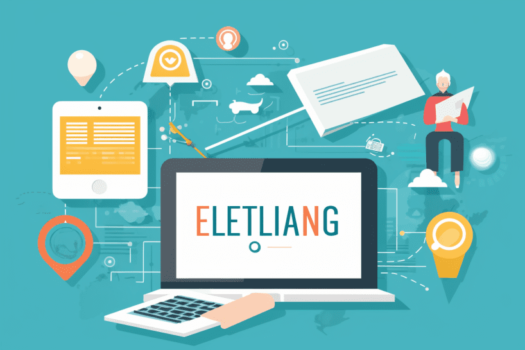Last Updated on July 6, 2023 by Said Al Azri
Introduction
Welcome to the world of e-learning! As businesses adapt to the digital age, e-learning platforms have become an essential tool for training and development. This guide is designed to help you navigate the process of selecting the right e-learning platform for your business, whether you’re a small startup or a large corporation.
The Rise of E-Learning
E-learning has revolutionized the way businesses operate. It offers flexibility, scalability, and accessibility, making it an attractive option for businesses of all sizes. From onboarding new employees to providing ongoing training, e-learning platforms can cater to a variety of learning needs.
Real-world examples of businesses successfully implementing e-learning are plentiful. For instance, multinational corporations like IBM have reported significant savings after shifting to e-learning. Small businesses, too, have benefited from the cost-effectiveness and flexibility of e-learning.
Understanding Your Business’s Needs
Before you start comparing different e-learning platforms, it’s crucial to understand your business’s specific learning needs. These needs can vary greatly depending on factors like the size of your team, the nature of the training content, and your learning objectives.
A small company with a few employees, for instance, could want a straightforward, user-friendly platform for basic training. A huge company with thousands of employees, on the other hand, could need a more powerful platform with cutting-edge features like in-depth tracking and reporting.
Key Features of E-Learning Platforms
When evaluating e-learning platforms, there are several key features to look for. These include user-friendly course creation tools, an intuitive user interface, robust tracking and reporting capabilities, and good customer support.
Each of these features plays a crucial role in the success of your e-learning program. For instance, user-friendly course creation tools make it easy for you to develop engaging content. An intuitive user interface ensures a smooth learning experience for your team. Robust tracking and reporting capabilities allow you to monitor your team’s progress and identify areas for improvement.
Evaluating Different E-Learning Platforms
There’s a wide range of e-learning platforms available, each with its own strengths and weaknesses. Some platforms are designed for small businesses, while others are better suited for large corporations. Some offer a wide range of features, while others focus on simplicity and ease of use.
When comparing different platforms, consider factors like pricing, customer support, and user reviews. Also, take advantage of free trials or demos to get a feel for how the platform works and whether it’s a good fit for your business.
Implementing the E-Learning Platform
Once you’ve chosen an e-learning platform, the next step is implementation. This involves setting up the platform, creating courses, and training your team to use it.
Successful implementation requires careful planning and ongoing support. Start by setting clear goals for your e-learning program. Then, develop a rollout plan that includes training for your team. Provide ongoing support to help your team make the most of the e-learning opportunities.
Measuring the Success of Your E-Learning Program
It’s important to measure the success of your e-learning program. This can be done through learner feedback, completion rates, and performance metrics. These insights can help you improve your program over time.
For instance, learner feedback can help you identify areas for improvement in your courses. Completion rates can give you an idea of how engaged your team is with the e-learning program. Performance metrics can help you assess the impact of the training on your team’s skills and productivity.
Future of E-Learning for Businesses
The world of e-learning is constantly evolving. As technology advances, new trends are shaping the future of corporate training. These include personalized learning, mobile learning, and the use of artificial intelligence in e-learning.
To ensure your e-learning program remains effective and engaging, it’s important to stay updated with these trends. Regularly review and update your courses to incorporate new learning methods and technologies.
Conclusion
Choosing the right e-learning platform is a crucial step in your business’s learning journey. With this guide, you’re well-equipped to make an informed decision. Remember, the best e-learning platform is one that meets your business’s unique needs and helps you achieve your learning objectives. We invite you to share your experiences or ask questions. Your e-learning journey starts here!
Top FAQs about Choosing an e-learning platform
1: What is an e-learning platform?
A digital system that enables the creation, administration, and delivery of educational content is known as an e-learning platform. Businesses can use it effectively to offer their staff members opportunities for training and development.
2: Why does my business need an e-learning platform?
Your company can save money, expedite training procedures, and give your staff flexible learning options with the use of an e-learning platform. It’s a terrific technique to guarantee that your staff members have the abilities and information required for success.
3: What features should I look for in an e-learning platform?
User-friendly course authoring tools, an easy user interface, powerful tracking and reporting capabilities, and solid customer service are essential qualities to look for in an e-learning platform.
4: How do I implement an e-learning platform in my business?
Implementing an e-learning platform involves setting up the platform, creating courses, and training your team to use it. It’s important to provide ongoing support to ensure your team can make the most of the e-learning opportunities.
5: How do I measure the success of my e-learning program?
You can measure the success of your e-learning program through learner feedback, completion rates, and performance metrics. These insights can help you improve your program over time.






